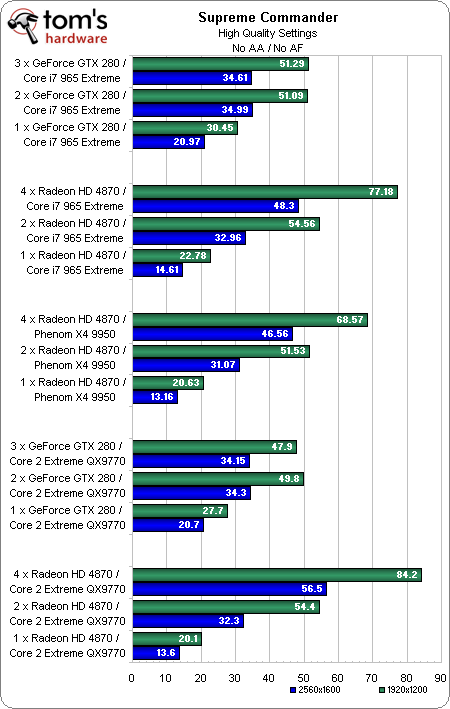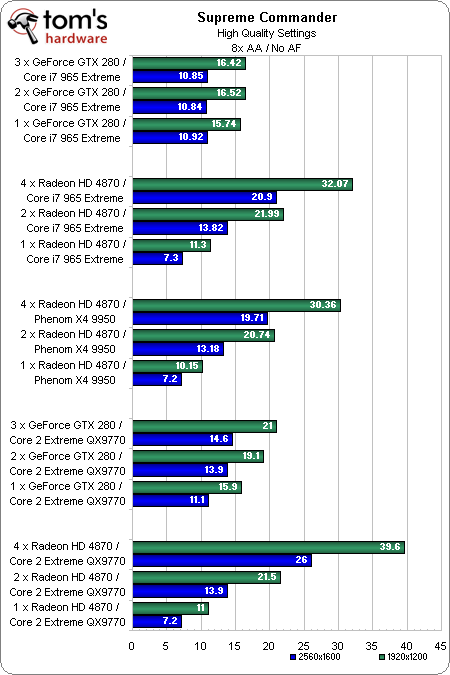Core i7: 4-Way CrossFire, 3-way SLI, Paradise?
Benchmark Results: Supreme Commander: Forged Alliance
Supreme Commander is an absolute hog for graphics horsepower—an observation made apparent by our benchmark results.

AMD’s Phenom X4 9950 bears mention in this comparison because, despite the processor’s disadvantage versus Intel’s own Extreme chips, the fact that the 790FX chipset has as many as four Radeon HD 4870s in it means that AMD can claim a victory against the X58- and X48-based configurations with GeForce GTX 280s in them. In fact, two Radeon HD 4870s in the Phenom X4 setup beat out three GTX 280s in either of the other Intel arrangements. Swap over the Radeons in the Intel platforms, though, and you have the makings of an even faster setup.
Nvidia’s GeForce GTX 280s do realize a substantial performance gain moving from one card to two, but adding the third board buys absolutely nothing. In fact, frame rates even step back a smidge. Likely, this has something to do with driver optimization, as Supreme Commander clearly responds very well to the addition of more graphics muscle.

Core i7 with one, two, or three GeForce GTX 280s is just ugly. There’s nothing to be gained once you crank up anti-aliasing in this title. Scaling on the Core 2 Extreme does exist, but it’s painfully weak. At least until Nvidia optimizes for Forged Alliance, there’s no point to buying second or third boards to speed up performance.
The Phenom X4-based setup competes readily with Intel’s new Core i7 965 Extreme. But if you really want to play this game with 8x anti-aliasing enabled, you’re going to need four Radeon HD 4870s and a Core 2 Extreme QX9770 at 1920x1200 for the most playable frame rates. The Core i7 and Phenom aren’t far behind at that res, but it is a greater than 20% gap.
Get Tom's Hardware's best news and in-depth reviews, straight to your inbox.
Current page: Benchmark Results: Supreme Commander: Forged Alliance
Prev Page Benchmark Results: World in Conflict Next Page Benchmark Results: Crysis 64-bit-
DFGum Yep, i hafta say being able to switch brands of graphics cards on a whim and selling off the old is great. Knowing im going to be getting the preformance these cards are capable of (better price to preformance ratio) is nice also.Reply -
cangelini randomizerSLI scales so nicely on X58.Reply
Hey you even got a "First" in there Randomizer! -
randomizer cangeliniHey you even got a "First" in there Randomizer!And modest old me didn't even mention it. :lol:Reply -
enewmen Still waiting for the 4870 X2s to be used in these bechmarks. I thought THG got a couple for the $4500 exteme system. But still happy to see articles like this so early!Reply -
cangelini enewmenStill waiting for the 4870 X2s to be used in these bechmarks. I thought THG got a couple for the $4500 exteme system. But still happy to see articles like this so early!Reply
Go check out the benchmark pages man! Every one with 1, 2, 4 4870s. The 2x and 4x configs are achieved with X2s, too.
Oh, and latest drivers all around, too. Crazy, I know! =) -
enewmen cangeliniI found it, just read the article too quickly. - My bad.Reply
"A single Radeon HD 4870 X2—representing our 2 x Radeon HD 4870 scores—is similarly capable of scaling fan speed on its own. "
Hope to see driver updates like you said. -
spyde Hi there, my question regarding these benchmarks with the HD card is, "was a 2G card use or a 1G". I am about to buy a new system and was looking to buy 2 x HD4870X2 2G cards, but with these results its looking a bit ify. I hope you can answer my question.Reply
Cheers. -
Proximon That's a nice article. I especially like the way the graphs are done. everything is scaled right, and you get an accurate representation.Reply
